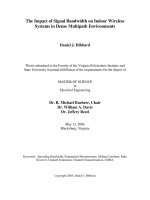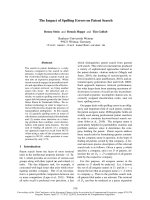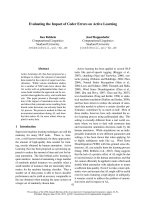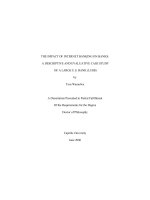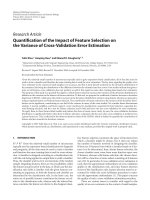The impact of financial literacy on financial inclusionin vietnam
Bạn đang xem bản rút gọn của tài liệu. Xem và tải ngay bản đầy đủ của tài liệu tại đây (919.17 KB, 68 trang )
THE STATE BANK OF VIET NAM
MINISTRY OF EDUCATION AND
TRAINING
BANKING UNIVERSITY HO CHI MINH CITY
---------------------
GRADUATION THESIS
PHAN ANH KHOA
THE IMPACT OF FINANCIAL LITERACY ON FINANCIAL
INCLUSION IN VIET NAM
Supervisor: Assoc. Prof. PhD. HA THI THIEU DAO
Ho Chi Minh 2021
COMMITMENT`
This thesis is the author's study. The research results are honest in that there
is no previously published content or other content done by someone else except
fully cited citations in the thesis.
Ho Chi Minh City, 29/09/2021
Khoa
Phan Anh Khoa
ABSTRACT
This thesis explores the impact of financial literacy and financial technology
on financial inclusion in the university in Viet Nam. It employs a sample of 567
respondents sampled across the 3 regions of Viet Nam from June 2021 to August
2021. Logistic regression was used to analyse of impact of financial literacy on
financial inclusion. The following empirical findings emanate from this thesis:
financial literacy positively and significantly affect financial inclusion. The thesis
discovers that financial literacy has a significant impact on financial inclusion
through owning a bank account. Finally, it shows that financial literacy and
Fintech has a significant impact on financial inclusion. Overall, the findings of
the study provide policymakers in Vietnam with recommendations.
ACKNOWLEDGEMENT
I would like to thank my teacher Ha Thi Thieu Dao, Assoc. Prof, Ph.D., for
supporting me to complete the project successfully.
I would like to express my gratitude to all my friends who have supported me
to share my survey in student groups.
This research would not have been possible without their support.
ABSTRACT .............................................................................................................. 3
ACKNOWLEDGEMENT ........................................................................................... 4
Chapter 1: INTRODUCTION ...................................................................................... 1
1.1.
Problem Statement ..................................................................................... 1
1.2.
Objectives ................................................................................................. 3
1.2.1.
Overall objective ..................................................................................... 3
1.2.2.
Specific objectives ................................................................................... 3
1.3.
Research questions ..................................................................................... 3
1.4.
Objectives and scope ................................................................................... 3
1.5.
Research methodology ................................................................................ 3
1.5.1.
Data ..................................................................................................... 3
1.5.2.
Regression method .................................................................................. 4
Chapter 2: RESEARCH LITERATURE REVIEW .......................................................... 6
2.1.
Financial inclusion ..................................................................................... 6
2.1.1.
Definition .............................................................................................. 6
2.1.2.
Financial inclusion measurement ............................................................... 7
2.2.
Financial literacy ....................................................................................... 8
2.2.1.
Definition .............................................................................................. 8
2.2.2.
Financial literacy measurement ............................................................... 10
2.3.
Determinants of financial inclusion .............................................................. 11
2.3.1.
Financial literacy and financial inclusion ................................................... 11
2.3.2.
Control variables .................................................................................. 12
2.4.
Summary ................................................................................................ 19
CHAPTER 3: RESEARCH METHODOLOGY............................................................. 20
3.1.
Research Data ......................................................................................... 20
3.2.
Regression method ................................................................................... 20
3.2.1.
Binary logistic model ............................................................................. 20
3.2.2.
Model specification................................................................................ 22
3.3.
3.3.1.
Testing ................................................................................................... 25
Omnibus Tests...................................................................................... 25
3.3.2.
3.4.
Hosmer and Lemeshow Test
................................................................... 26
Summary ................................................................................................ 26
CHAPTER 4: RESULT OF STUDY AND DISCUSSIONS .............................................. 27
4.1.
Descriptive statistics ................................................................................. 27
4.1.1.
Demographic statistics ........................................................................... 27
4.1.2.
Financial Inclusion Statistics ................................................................... 29
4.1.3.
Financial literacy statistics ...................................................................... 30
4.2.
Regression results and discussions ............................................................... 31
4.3.
Summary ................................................................................................ 37
CHAPTER 5: CONCLUSIONS AND RECOMMENDATIONS ........................................ 38
5.1.
Conclusions ............................................................................................. 38
5.2.
Recommendations .................................................................................... 38
5.3.
Limitation and research future ................................................................... 40
REFERENCE ......................................................................................................... 41
APPENDICES ......................................................................................................... 51
LIST OF ABBREVIATIONS
Fintech
HCM
VL
LC
Financial Technology
Ho Chi Minh
Vinh Long
Lai Chau
LIST OF TABLES
Table 2.1 Conceptual definitions of financial literacy ............................................................ 9
Table 2.2 Summary of previous research on financial inclusion ............................................. 16
Table 3.1 Summary of variable in the research .................................................................. 23
Table 4.1 Demographic statitics .................................................................................... 28
Table 4.2 Percentage of owning an account ...................................................................... 30
Table 4.3 Score of financial literacy ............................................................................... 31
Table 4.4 Result of regression of financial inclusion ........................................................... 33
Table 4.5 Probability of owning an account ...................................................................... 36
Chapter 1: INTRODUCTION
1.1. Problem Statement
In the development of industry 4.0, one of the most vital factors determining
the development and growth of the national financial system in the current
integration context is financial inclusion. Financial inclusion offers many benefits
for individuals and businesses to access financial services affordably and
conveniently. Financial inclusion also helps them have a good view of savings,
investment, ability to create assets, and improve quality of life. For a developing
country like Viet Nam, financial inclusion is increasingly becoming a vital pillar
of the country's development.
Besides that, financial literacy plays an important role in furthering financial
inclusion (Grohmann, FKlühs & Menkhoff, 2018). Financial literacy contributes
to the improvement of social life, economic development and social well-being.
To catch up with Industry 4.0's development, many countries have developed and
implemented national programs and strategies to improve financial literacy and
financial education. In this way, financial literacy becomes one of the essential
skills for all members of society. However, the impact of financial literacy of
financial inclusion can be reversed by objective factors. Babych, Grigolia &
Keshelava (2018) demonstrate that low income levels, lower financial behavior
may be in part responsible for low levels of financial inclusion and thus, indirectly,
lead to lower levels of financial literacy. Several studies in developing countries
have also confirmed that better financial literacy is positively associated with
participation in financial markets, the use of formal sources of borrowing
(Klapper et al., 2017).
Despite the benefits of financial literacy, financial illiteracy exists worldwide.
The full benefits of financial inclusion are difficult to realize because of this
phenomenon (Akakpo, 2020). Although financial literacy is an important tool,
1
economic and social barriers to access may need to be overcome before financial
literacy can be effective (Lyons, Chang, & Scherpf, 2006). Many studies have
been advanced towards the financial literacy and financial inclusion
discourse due to the global financial crisis, with an increased emphasis on the role
of financial literacy in increasing access to, and use of, financial services (Xu &
Zia 2012). For instance, Menon (2019) suggested that financial inclusion must be
accompanied by financial literacy in order to achieve the best results. Grohmann,
Klühs & Menkhoff (2018) emphasized that proving the stylized fact that higher
financial literacy is systematically linked to better financial inclusion at the
national level.
Recently, there has been limited research that pulls on finance theory to
research whether Fintech can help financial inclusion and the way this might
ultimately shed light on the intractable problem of lack of financial literacy.
However, World Bank support in 2011, 2014 and 2017 provided evidence on the
connection between Fintech and financial inclusion.
However, financial inclusion in Vietnam continues to be limited. According
to World Bank’s Global Findex (2017), in Viet Nam, only 31% of people have
accounts, which is higher than Cambodia (22%) and Lao (29%) and this figure is
a warning to the government. About 69% of adults in Vietnam are non-banked
and therefore dependent on money to buy or sell goods and services.That means
that out of Vietnam's 97 million citizens, there are approximately 50 million
people, aged 15 and over, relying on cash (World Bank, 2018). The number of
deposit accounts with commercial banks in Viet Nam per 1000 adults is
approximately 1194,86, which is only higher than Lao (672,47) and Cambodia
(376,39). Furthermore, while financial inclusion has improved significantly in
other Asian economies, progress in Vietnam appears to be slow. Some recent
studies have been conducted on how financial literacy can help improve financial
inclusion in economies that are progressing slowly (Babajide, Adegboye &
2
Omankhanlen, 2015; Sethi & Acharya, 2018; Sharma, 2016). This search
complements the blanks.
Thereby it can be seen that the impact of financial literacy and financial
inclusion plays an important role. Lack of financial literacy will lead to
ineffective financial decisions. What is the impact of financial literacy on
financial inclusion in Vietnam? This research will add a certificate about the
effect of financial literacy and financial inclusion. That is also why we chose the
topic “financial literacy and financial inclusion”.
1.2. Objectives
1.2.1. Overall objective
The main focus of this study is to determine the impact of financial literacy
on financial inclusion and increasing positive influences to financial inclusion.
1.2.2. Specific objectives
- Examining financial literacy impacts on financial inclusion.
- Exploring level of impact of financial literacy on financial inclusion.
1.3. Research questions
After identifying the research objectives as outline above, a few research
question is issued.
- Does financial literacy affect financial inclusion?
- What is the impact level of financial literacy on financial inclusion ?
1.4. Objectives and scope
- Objectives: The research survey the students from the universities.
- Scope: The research chooses 3 regions in Viet Nam: Ho Chi Minh, Vinh Long
and Lai Chau.
1.5. Research methodology
1.5.1. Data
The data collect by online survey. Data collected about 567 students
completed the questionnaire and were selected for analysis. The study selected
3
three random regions to represent: the highlands (Lai Chau), the downtown (Ho
Chi Minh city), and the plains (Vinh Long) based on the bank's distribution
density.
1.5.2. Regression method
This research employs quantitative regression techniques. The study employs
logistic regression approach and uses the software SPSS. This estimate measures
causality from the outcome variables of financial literacy and financial inclusion.
It is the objective of the study to establish how financial literacy and financial
inclusion.
1.6. Research contributions
Providing an empirical evidence for Vietnamese students about the impact of
financial literacy on financial inclusion
Helping students improve financial inclusion and supporting policies for
financial inclusion policy makers.
Promoting financial literacy courses by teaching calculation skills about
interest rate, inflation, risk, ....
Encouraging students to live independently to hone skills such as payment,
money transfer, savings so that students can easily access banking services.
Working will help students have easier access to financial inclusion through
payment and shopping services.
Increasing student spending needs to make it easier for them to access
financial inclusion.
1.7. Research structure
The research is divided into five sections. The first chapter provides an
overview of the research topic. The second chapter is dedicated to a literature
review. The review concentrates on empirical and theoretical research in the areas
of financial inclusion, financial literacy. In chapter three, the study's methodology
is presented in detail. It encompasses the research design, population, data
collection, model specification, dependent and independent variable selection,
4
and data analysis mode. The study's results and discussions are presented in
Chapter 4. It provides an interpretation of the findings and backs them up with
research on financial inclusion, financial literacy. The study's conclusion is
presented in chapter five. This chapter also includes recommendations and
limitations.
5
Chapter 2: RESEARCH LITERATURE REVIEW
2.1. Financial inclusion
2.1.1. Definition
Financial inclusion has been a much-researched topic in recent years. A
series of studies have examined the important role of financial inclusion.
Financial inclusion is the process of regulated mainstream institutional players
providing appropriate financial products and services to all sections of society in
general, and vulnerable groups such as weaker sections and low-income groups
in particular, at an affordable cost fairly and transparently (Chakrabarty, 2011).
Sarma & Pais (2011) illustrated that financial inclusion is a process that assures
that all members of an economy have easy access to, and use of, the official
financial system. Financial inclusion outreach can be characterized generically
as the process of providing all members of society with a range of necessary
financial services at a reasonable cost, at the appropriate location, form, and time,
and without discrimination (Aduda & Kalunda, 2012). Despite the different
definitions, financial inclusion is believed to be individuals' access to relevant
financial products and services (Hayton & alt, 2007). Financial inclusion is an
indispensable sector of economic growth and poverty reduction (World Bank,
2018). Multilateral organizations have repeatedly emphasized the benefits of
universal access to financial services and emphasized the global committed to
expanding financial inclusion as a means of economic and social improvement
around the world (World Bank, 2018). Besides that, Kirana & Havidz (2020)
concluded that better financial knowledge, behavior, perceived usefulness, and
ease of use may promote financial inclusion and are more reachable since the
poor can access and use financial products and services as well as improve their
quality of life and welfare of society. Moreover, financial inclusion adding value
to small and medium enterprises (Demirgỹỗ-Kunt, Honohan & Beck, 2008).
6
2.1.2. Financial inclusion measurement
Financial inclusion has been studied in countries around the world.
Fungaova & Weill (2014 ) examined financial inclusion in China using data from
the 2011 World Bank Global Findex database through using financial services
such as formal account, formal credit, access to formal education,… Zins & Weill
(2016) used the World Bank's Global Index database to discover that in Africa,
being a man, who is wealthier, more educated, and older, favors financial
inclusion, with education and income having a better influence. Besides that,
Léon & Zins (2020) also used datasets from World Bank Global Findex; and the
World Bank's Business Survey to measure financial inclusion. Almost all of the
studies use data from the World Bank's Global Findex database, which takes
advantage of the standardized questionnaire used to collect indicators from all
countries, makes it easy to compare metrics or aggregate data across the countries.
Researchers, governments, and policymakers are concerned about how to
evaluate financial inclusion. While the causes and consequences of financial
inclusion are still being investigated around the world. There is no consensus on
how it should be defined and quantified. As previously stated, most studies
continue to define “financial inclusion” in terms of formal bank account
availability, usage, and quality (Lyons & Kass-Hanna,2021). According to Allen,
Demirguc-Kunt, Klapper, and Martinez Peria (2016), financial inclusion is
measured using a variety of indicators such as "owner account", "owner bank
card”, "savings" and so on. The study focuses on the indicator “owner an account”
due to previous research (Lusardi, Schneider, & Tufano, 2011; Demirgỹỗ-Kunt
et al, 2015; Grohmann, Klühs & Menkhoff, 2018; Lyons, Grable & Joo, 2018;
World Bank, 2017; …). “Owner an account” is the most important indicator.
They identify those who have a formal bank account where they could potentially
save. Individuals who are "financially inclusion" in the mainstream financial
system are referred to as "financially inclusion”. However, just because you have
7
a formal account doesn't mean you'll use it. According to World Bank (2017),
having a bank account is a crucial first step toward financial inclusion.
2.2. Financial literacy
2.2.1. Definition
Atkinson & Messy (2012) has defined financial literacy as “a combination of
awareness, knowledge, skill, attitude, and behavior necessary to make sound
financial decisions and ultimately achieve individual well-being”.Financial
literacy has occupied a prominent place on the policy agenda of many countries
(OCED/2015). Lusardi (2019) found that financial literacy affects everything
from daily to long-term financial decisions, and this has implications for both
individuals and society. Low levels of financial literacy across countries correlate
with inefficient financial planning and spending, as well as expensive debt and
debt management. Moreover, financial literacy beyond understanding, covering
aspects of financial behavior and attitudes (OCED/2020).
Financial literacy can be defined in various ways, depending on the
perspective of the individual and the researcher. In the simplest definition,
Atkinson & Messy (2012) has defined financial literacy as “a combination of
awareness, knowledge, skill, attitude and behavior necessary to make sound
financial decisions and ultimately achieve individual well-being”. In details, it is
the “knowledge of basic financial concepts, such as the working of interest
compounding, the difference between nominal and real values, and the basics of
risk diversification” (Lusardi, 2008). In some practical views, financial literacy
is defined: “The ability to make informed judgments and to take effective
decisions regarding the use and management of money ”. ANZ Bank (2008) and
Gowri (2015) seem to have a more comprehensive understanding about financial
literacy. In general, financial literacy is a broad term, and research on it focuses
on analyzing financial literacy outcomes, assessing levels among various
population cohorts, factors impacting financial literacy, and the impact of
8
financial education on enhancing financial literacy (Goyal & Kumar, 2020). . In
short, financial literacy is synthesis of an individual's perceptions, attitudes, and
skills toward financial matters.
Table 2.1 Conceptual definitions of financial literacy
Source
Conceptual definitions
PACFL (2008)
The ability to use knowledge and skills
for the effective management of
financial resources for long-term
financial well-being.
Huston (2010)
The knowledge of personal finance as
well as the application of that
knowledge.
Lusardi and Mitchell (2011)
The knowledge of basic financial
concepts and ability to do simple
calculations.
Messy (2014)
Knowledge and understanding of
financial concepts and risks, and the
skills, motivation and confidence to
apply
such
understanding
knowledge
to
make
and
effective
decisions across a range of financial
contexts, to improve the financial
well-being of individuals and society,
and
to
enable
economic life.
9
participation
in
Sahadeo (2018)
Financial literacy is a combination of
the awareness, knowledge, abilities,
attitudes, and habits needed to make
sound
financial
ultimately,
to
decisions
achieve
and,
individual
financial well-being.
Santini (2019)
The constructs of financial literacy as
financial
attitude,
financial
knowledge, and financial behavior.
Swiecka (2020)
Financial literacy as the knowledge
and
understanding
of
financial
concepts and risks.
Source: The author synthesized
2.2.2. Financial literacy measurement
The development of financial literacy led to many studies and a variety of
questions being formed. Klapper, Lusardi & Van Oudheusden (2015) choose the
definition of a financial literate as someone who correctly answers three out of
four questions assessing financial knowledge on four simple concepts
(knowledge of interest rate, interest compounding, inflation, and risk
diversification). In the United Arab Emirates, Al-Tamimi & Kalli (2009)
measured the financial literacy of UAE investors using 18 exam-type true-orfalse questions covering the main aspects of investment management. Studies
also extend the measurement to a variety of factors, Brown, Henchoz & Spycher
(2018) measured financial literacy by surveying and comparing secondary-school
students along the German–French language border within Switzerland,
Gunawan & et. al (2021) explored financial literacy have paid attention to issues
related to gender with a particular focus on women, Lusardi, Mitchell & Curto
(2010) also paid attention to financial literacy with an emphasis on the youth and
10
their determinant. Financial literacy studies have suggested that financial services
professionals should take advantage of the many benefits presented by financial
education (Akakpo, 2020).
Financial literacy score proposed in Klapper et.al (2015), which is used there
is a dummy variable, given “1” if the question is answered correctly and the other
responses are given value "0". The mean percentages of correct scores were
divided into three categories, as suggested by the literature (Chen & Volpe, 1998):
(a) over 80%, representing a relatively high level of knowledge; (b) 60% to 79%,
representing a medium level of knowledge; and (c) below 60%, representing a
low level of knowledge.
The research followed Klapper et.al (2015) and Ergün (2018), that means
the research divided student in two group. Students who scored higher than the
average were classified as more financial literacy. Students below the median
score were classified as less financial literacy. In this study, financial literacy was
assumed to be positively related to financial inclusion. However, the person who
answers all questions correctly cannot be considered financial professionals. The
financial literacy questions cover the following topics: interest rates, interest
compounding, inflation, and risk diversification.
2.3. Determinants of financial inclusion
2.3.1. Financial literacy and financial inclusion
Most studies have found that financial literacy has played an important role
in creating financial inclusion (Trianto, Barus & Sabiu 2021; Grohmann &
Menkhoff 2020; Lyons & Kass-Hanna 2019; Bongomin, Munene, Ntayi &
Malinga 2018;...). Financial Inclusion is a lofty ideal but financial Literacy is the
first step towards achieving Financial Inclusion (Ramakrishnan, 2012). Financial
literacy impact on financial inclusion through many factors: saving behavior
(Morgan & Long 2020), income (Adetunji & David‐West 2019), financial
education (Ramakrishnan 2012), financial tenology (Morgan & Trinh 2019),... In
11
addition, the World Bank also has many studies exploring the impact of financial
literacy on financial inclusion detail as: The World Bank Global Financial
Development Report on Financial Inclusion (2014) states that financial literacy
has statistical and economic implications on financial behavior. However, these
studies ignore the role of social capital as a critical factor in mediating between
financial literacy and financial inclusion, especially Fintech. A large number of
research have been published to the link between financial literacy and financial
inclusion. Financial inclusion is seen as a critical tool for promoting inclusive
growth and reducing poverty (Morgan & Long, 2020). Bongomin, Munene &
Yourougou (2020) found that financial intermediaries help people become more
financially literate, which leads to greater financial inclusion.They also found that
financial inclusion is improved as a result of increased financial literacy.
According to Grohmann et al (2018), financial literacy has a beneficial effect on
financial services, which is a good influence on people of all income levels and
subgroups within countries with different features. According to the World Bank
(2008), financial literacy aids in improving financial service efficiency and
quality. Moreover, Lusardi (2008) also suggested that financial literacy supports
in the empowerment and education of the poor so that they are knowledgeable
and capable of evaluating various financial products and services to make
informed financial decisions and get maximum benefit. Financial literacy
promotes decision-making, which improves savings rates and potential
borrowers' credit worthiness, leading in greater access and usage of financial
services by the poor (OCED 2009).
2.3.2. Control variables
- Fintech
The majority of studies now show that Fintech is an important driver of
financial inclusion ( Jack & Suri, 2013; Gosh 2016; Gosavi 2018;…). Besides
that, there is also evidence of a link between mobile money use and household
12
and firm financial inclusion. According to Andrianaivo & Kpodar (2012), there
is evidence of a strong link between mobile phone penetration and financial
inclusion in both developed and developing countries. Through its effects on
increased access to bank credit, mobile money has also been found to have a
positive impact on SME financial inclusion (Gosavi, 2018). Households with a
mobile money account are more likely to be banked, receive/send remittances on
a more regular basis, and save more money (Morawczynski, 2009; Jack & Suri,
2011; Mbiti & Weil, 2011,…). Through that, In countries where the majority of
the population is unbanked (or informally banked) but owns a mobile phone,
mobile technology has enormous potential for expanding the reach of the formal
banking system (Demir, Pesqué-Cela, Altunbas, & Murinde, 2020).
Fintech is considered an independent variable in this study. Following the
previous researches, mobile phone penetration and fixed broadband penetration
are the instruments used in Fintech (Andrianaivo & Kpodar 2012; Ghosh 2016;
Demirgỹỗ-Kunt et al. 2018). However, despite the fact that there are a variety of
measurement tools available, most studies opt for a common metric, which is the
use of telephone services. In this study, the factor “using mobile to payment” was
used to measured Fintech. The use of mobile phones to pay bills is a proxy for
Fintech (Asongu & Odhiambo, 2018; Asongu & Nwachukwu, 2018; Demir,
Pesqué-Cela, Altunbas, & Murinde, 2020).
- Demographics
According to a growing body of evidence, individual characteristics can
influence financial inclusion. Individual characteristics such as gender, age,
education, and income levels have been identified as key factors influencing
financial inclusion in the literature. For instance, Soumaré et al (2016) proved
that gender, education, age, income, residence area, employment status, marital
status, household size, and degree of trust in financial institutions all played a role
in financial inclusion. Shihadeh (2018) also investigates how personal
13
characteristics influence financial inclusion in the MENAP region. Zins & Weill
(2016) use the World Bank's Global Index database to find that in Africa being a
man, richer, more educated and older, favor financial inclusion with a higher
influence of education and income. Evans (2016) also identified the factors that
influenced financial inclusion in Africa from 2005 to 2014. Financial inclusion
was found to be driven by per capita income, broad money as a percentage of
GDP, literacy rate, internet access, and the presence of Islamic banking activities.
In Sub-Saharan Africa, macroeconomic variables, age, education, gender, and
affluence are individual-level covariates that have a significant impact on
financial inclusion (Asuming et al, 2019).
Within the research, some studies have even taken a more localized approach
to investigate the relationship between financial inclusion and financial
technology. For example, mobile money allows users to conduct financial
transactions such as bill payments, savings, money transfers, loan acquisition, and
product and service purchases (Donovan, 2012). The provision of financial
services via mobile phones and related devices can improve access to finance for
the excluded population (World Bank, 2016). According to Bongomin & et.al
(2018), social networks improved financial inclusion in Uganda by increasing
social cohesion. Evans (2018) examine the relationship between the internet,
mobile phones and financial inclusion in Africa from 2000 to 2016, and find that
the internet and mobile phones improved the ability of individuals to access basic
financial services thereby increasing the level of financial inclusion.
Gender is considered an independent variable in this study. Individual
characteristics may influence both financial inclusion and financial literacy
(Allen et al, 2016). According to previous studies, it was assumed that women
and men have different financial capabilities such as: in South Africa, women
mostly use formal transactional products and informal financial mechanisms,
while men mostly use formal credit, insurance, and products (Nanziri, 2016);
14
women in Comoros either lack money or are unaware of available financial
services, making it difficult for them to escape poverty (Ali, 2019).
Age is an independent variable in the study because the use of bank accounts
is expected to rise and fall with age. In terms of financial inclusion, studies look
at the adult population aged 15 and up because they have a better chance of being
financially educated and included in the financial system (Akakpo, 2020). A
higher age dependency ratio should reduce financial inclusion because a larger
portion of the population is either too young or too old to work, preventing them
from accessing financial services because they do not earn an income (Park &
Mercado, 2015).
Place of study is also an independent variable in the study because where
respondents are located often has a relationship with their levels of financial
education and financial inclusion (Lyons & Kass-Hanna, 2021) showed that The
comparison of urban and rural areas adds to our understanding of which types of
financial services and products are most effective in different geographical
locations and for different types of people. Marshall (2004) emphasized that
People and their geographical location can have an impact on their ability to
participate in the formal financial system.
Educational level is considered as the correlation between financial literacy
and financial inclusion because individuals who are more educated are better able
to comprehend basic financial concepts and use financial products. According to
Fungáová and Weill (2015), higher income, better education, being a man, and
being older are all linked to more use of formal accounts and formal credit in
China. Yangdol & Sarma (2019) looked at the demand-side factors that affect
financial inclusion and found that higher levels of education and income increase
people's financial inclusion.
15
Field of study is also an independent variable in the study because major of
respondents often have a relationship with their levels of financial literacy and
financial inclusion. Ergün (2018) shows that the impact of finance courses on
financial literacy is significant.
Employment status is also an independent variable because their employers
are likely to require an account for the payment of their salaries. Demirgỹỗ-Kunt,
Klapper & Singer (2013) used the Global Findex database to show that the
employment status is a key determinant of owning an account. According to
Ghosh & Chaudhury (2019), the lack of a bank account, formal savings, and
formal credit requirements are primarily due to females' lower employment status.
Finance your course is considered as the correlation with financial literacy
and financial inclusion because individuals who are more educated are better able
to their decision. People had to be careful with the limited financial resources
provided by education service providers in the form of a scholarship or a study
loan to cover university and personal expenses that are critical to their education
and financial success (Hazudin, Tarmuji, Kader, Majid, Aziz & Ishak, 2018).
Spending is spending will increase students' financial inclusion. Households
with very limited resources will prioritize spending their resources to resolve food
security and health problems rather than buy a mobile phone (Abor, Amidu &
Issahaku, 2018; Duflo, 2012).
Table 1.2 Summary of previous research on financial inclusion
Authors
Time
and Variables
Method
regression
Region
Regime place
16
Result
Trianto,
102
Barus
& respondents,
Sabiu,
(2021).
Gender;
PLS-SEM
Financial
Education;
literacy has an
culinary
Age; Finacial
important role in
business
literacy,
creating
owners
in Financial
financial
Pekanbaru,
inclusion,
inclusion
Indonesia.
Growth.
also
and
providing
better
opportunities for
business
development for
business actors.
Grohmann
2020
Varibles:
Qualitative
Financial
& Menkhoff
Financial
Method
inclusion can be
(2020).
literacy,
seen as having
financial
three
different
inclusion,
levels.
At
financial
third
development.
financial literacy
the
level,
involves rational
use of financial
services.
Lyons,
24,047
Finacial
Analysis
The
Grable
& respondents
literacy,
regression
indicated
Financial
17
study
that
there is evidence

